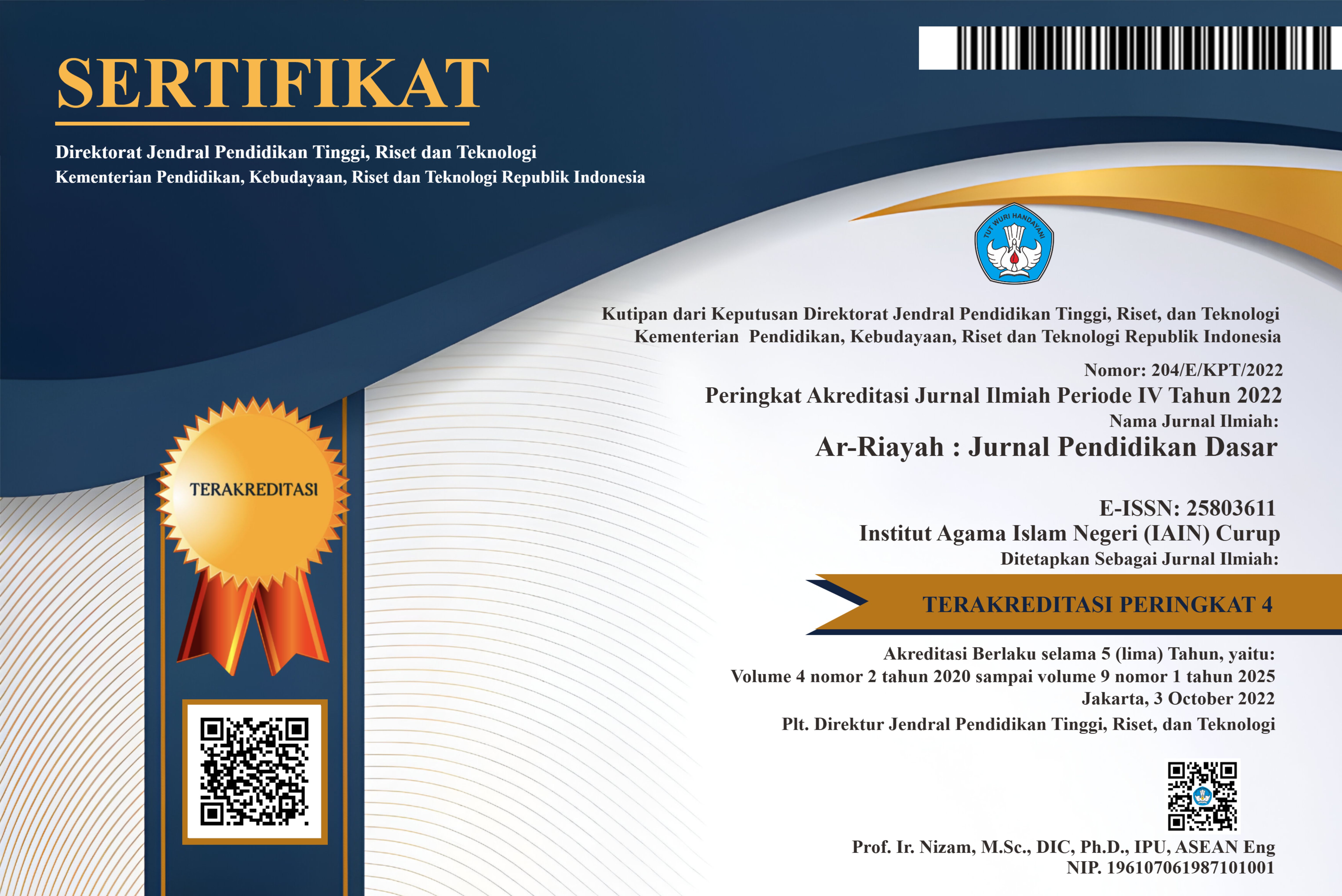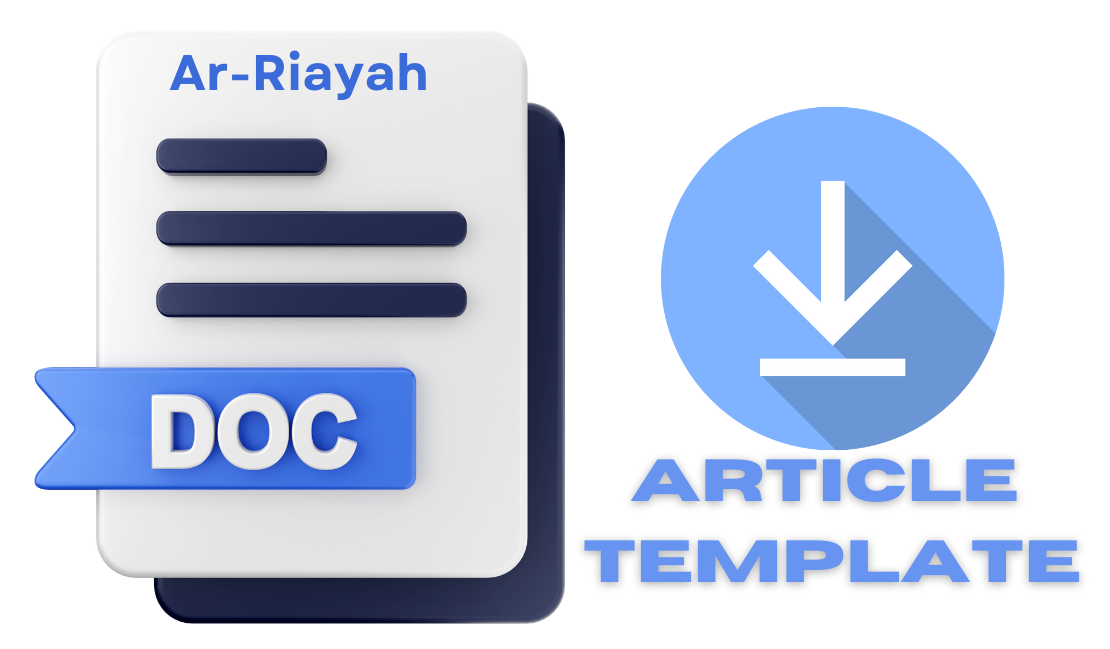Metode Story Telling dalam Meningkatkan Motivasi Belajar Sejarah Kebudayaan Islam
DOI:
https://doi.org/10.29240/jpd.v5i2.3424Keywords:
Story Telling, Learning MotivationAbstract
This study aims to analyze and examine the application of the Story Telling method as an effort to increase motivation to learn Islamic Cultural History. The research method used is a descriptive qualitative approach with the type of case study. The research location is in class 5 MI Nurul Mun'im, Paiton District, Probolinggo Regency. Meanwhile, the data collection instruments used in this study included direct observation and unstructured interview notes to support the completeness of the data. Data analysis techniques consist of collecting data, reducing data, presenting data, and then concluding these conclusions. The results obtained from the application of the storytelling method are student learning motivation in following the lesson, students are invited to understand the material in a fun way, namely by telling stories in front of the class. The implication is that students' learning motivation can be achieved by using variations in learning by the teacher so that students do not get bored in class.
Downloads
References
Andriyansyah, A. “Penanaman Toleransi Agama Pada Diri Anak Melalui Doktrin Sejarah Kebudayaan Islam (PENELITIAN TINDAKAN KELAS PADA MI HIDAYATUL AHBABINA, SETU, BEKASI).†El Banar: Jurnal Pendidikan Dan Pengajaran 02, no. 02 (2019): 121–26. http://ojs.staibanisaleh.ac.id/index.php/ElBanar/article/view/39.
Aslan. “IMPLEMENTASI METODE CERITA PADA MATA PELAJARAN SEJARAH KEBUDAYAAN ISLAM DI KABUPATEN SAMBAS(Studi Kasus Pada Madrasah Ibtidaiyah SwastaDarul Ulum Matang Danau Kecamatan Paloh).†Cross Border: Jurnal Kajian Perbatasan Antarnegara, Diplomasi, Dan Hubungan Internasional 2, no. 1 (2019): 50–66.
Azizeh, Siti Nur. “METODE KISAH DALAM MENINGKATKAN MOTIVASI BELAJAR DAN KEMAMPUAN BERCERITA PADA PEMBELAJARAN SEJARAH KEBUDAYAAN ISLAM DI MADRASAH IBTIDAIYAH.†Al Insyiroh: Jurnal Studi Keislaman 7, no. 1 (2021): 88–114.
Balqis, Salsabila. “Wawancara Siswa.†In Siswa Kelas V MI Nurul Mun’im, 1, 2021.
Benardi, Andi Irwan. “Pendidikan Kesiapsiagaan Bencana Tanah Longsor Untuk Siswa Anak Usia Dini Dengan Metode Dongeng Berbasis Media Pop Up Book Di Paud Dewi Sartika Kecamatan Bergas.†Jurnal Pendidikan Geografi 23, no. 2 (2018): 85–93. https://doi.org/10.17977/um017v23i22018p085.
Darojatun, Naila. “Wawancara Siswa.†In Siswa Kelas V MI Nurul Mun’im, 1, 2021.
Emda, Amna. “Kedudukan Motivasi Belajar Siswa Dalam Pembelajaran.†Lantanida Journal 5, no. 2 (2018): 172. https://doi.org/10.22373/lj.v5i2.2838.
Farida, Nugrahani. Metode Penelitian Kualitatif Dalam Penelitian Pendidikan Bahasa. Grasindo. Vol. 1, 2014. http://e-journal.usd.ac.id/index.php/LLT%0Ahttp://jurnal.untan.ac.id/index.php/jpdpb/article/viewFile/11345/10753%0Ahttp://dx.doi.org/10.1016/j.sbspro.2015.04.758%0Awww.iosrjournals.org.
Farohiyah, Safira Nayla. “Wawancara Siswa.†In Siswa Kelas V MI Nurul Mun’im, 1, 2021.
Hidayah, Nurul, and Witri Anisa. “Peningkatan Motivasi Belajar Dan Kemampuan Berpikir Kritis Peserta Didik Menggunakan Model Think Pair Share Berbantuan Alat Peraga Bahan Bekas.†AR-RIAYAH : Jurnal Pendidikan Dasar 3, no. 2 (2019): 165. https://doi.org/10.29240/jpd.v3i2.1186.
Irfangi, M. “Implementasi Metode Kisah Dalam Pembelajaran Akidah Akhlak Di Madrasah Aliyah.†Jurnal Kependidikan 5, no. 1 (2017): 87–104. https://doi.org/10.24090/jk.v5i1.1255.
Irwansyah, Muhammad Ferry, and Endah Retnowati. “Efektivitas Worked Example Dengan Strategi Pengelompokan Siswa Ditinjau Dari Kemampuan Pemecahan Masalah Dan Cognitive Load.†Jurnal Riset Pendidikan Matematika 6, no. 1 (2019): 62–74. https://doi.org/10.21831/jrpm.v6i1.21452.
Jumrawarsi, and Neviyarni Suhaili. “Peran Seorang Guru Dalam Menciptakan Lingkungan Belajar Yang Kondusif.†Ensiklopedia Education Review 2, no. 3 (2020): 50–54.
Kamaluddin, Muhammad. “Pengaruh Motivasi Belajar Terhadap Prestasi Belajar Matematika Dan Strategi Untuk Meningkatkannya.†Seminar Matematika Dan Pendidikan Matematika 67, no. 9 (2017): 455–60.
L. Ariani, and D. S. Hariyono. “Storytelling Sebagai Metode Dalam Mengembangkan Kemampuan Berbahasa Pada Anak Prasekolah.†Prosiding Seminar Nasional & Call Paper Psikologi Pendidikan, 2019, 36–44. http://fppsi.um.ac.id/wp-content/uploads/2019/07/5-STORYTELLING-SEBAGAI-METODE-DALAM-MENGEMBANGKAN-KEMAMPUAN-BERBAHASA-PADA-ANAK-PRASEKOLAH-36-44.pdf.
Lauryn, Maya Selvia, M. Ibrohim, and Mochammad Rizqi Amirullah. “Pengembangan Metode Storytelling Berbasis Game Edukasi Dalam Pembelajaran Sejarah Sahabat Nabi.†ProTekInfo(Pengembangan Riset Dan Observasi Teknik Informatika) 6, no. 1 (2019): 21. https://doi.org/10.30656/protekinfo.v6i1.1745.
Lestari, Dwi Puji. “Peningkatan Perilaku Anti Korupsi Melalui Metode Story Telling.†Raudhatul Athfal: Jurnal Pendidikan Islam Anak Usia Dini 2, no. 1 (2018): 95–105. https://doi.org/10.19109/ra.v2i1.2238.
Lestari, Wahyu, Loviga Denny Pratama, and Jailani Jailani. “Implementasi Pendekatan Saintifik Setting Kooperatif Tipe STAD Terhadap Motivasi Belajar Dan Prestasi Belajar Matematika.†AKSIOMA : Jurnal Matematika Dan Pendidikan Matematika 9, no. 1 (2018): 29. https://doi.org/10.26877/aks.v9i1.2332.
Miles, Matthew B., A. Michael Huberman, and Johnny Saldana. “Qualitative Data Analysis: A Methods Sourcebook, 3/E.†In Sage Publication, Third., 341. New York: SAGE Publications, 2013.
Naim, Achmad. “APLIKASI COOPERATIF LEARNINGTIPE GROUP INVESTIGATION ( GI)PADA MATA PELAJARAN SEJARAH KEBUDAYAAN ISLAM DI KELAS V FAVORITMI SALAFIYAH SYAFI’IYAHSUKOREJO SITUBONDO, TAHUN PELAJARAN 2015/2016.†Journal Al Murabbi 3, no. 1 (2016): 92–105.
Putri, Wakhidati Nurrohmah. “Pengaruh Media Pembelajaran Terhadap Motivasi Belajar Bahasa Arab Siswa Madrasah Tsanawiyah.†LISANIA: Journal of Arabic Education and Literature 1, no. 1 (2017): 1–16. https://doi.org/10.18326/lisania.v1i1.817.
Qoimah. “Wawancara Guru.†In Wali Kelas V MI Nurul Mun’im, 1, 2021.
Raco, Jozef. “Metode Penelitian Kualitatif: Jenis, Karakteristik Dan Keunggulannya.†In Grasindo. Grasindo, 2018. https://doi.org/10.31219/osf.io/mfzuj.
Ramdhani, Sandy, Nur Adiyah Yuliastri, Siti Diana Sari, and Siti Hasriah. “Penanaman Nilai-Nilai Karakter Melalui Kegiatan Storytelling Dengan Menggunakan Cerita Rakyat Sasak Pada Anak Usia Dini.†Jurnal Obsesi : Jurnal Pendidikan Anak Usia Dini 3, no. 1 (2019): 153. https://doi.org/10.31004/obsesi.v3i1.108.
Ratumbuysang, Monry FNG. “Penguatan Karakter Wirausaha Melalui Metode Story Telling Sejarah Berdagang Nabi Muhammad Dan Sahabatnya.†Jurnal Ecopsy 4, no. 3 (2017): 133. https://doi.org/10.20527/ecopsy.v4i3.4292.
Resi Amelia Syarwah, Moh. Fauziddin dan Adityawarman Hidayat. “Peningkatan Motivasi Belajar Siswa Menggunakan Media Audio Visual Pada Pembelajaran Bahasa Indonesia.†Jurnal Pendidikan Tambusai 3, no. 5 (2019): 936–45.
Roizah, Zuyyimatur. “Wawancara Guru.†In Guru Sejarah Kebudayaan Islam, 3:24090, 2021.
Rozi, Fathor. “Variations in Learning Methods; Upaya Dalam Mencetak Pakar Fiqh Melalui Pengembangan Pembelajaran Kitab Kuning Di Ma’had Aly.†Tafaqquh: Jurnal Penelitian Dan Kajian Keislaman 9, no. 1 (2021): 81–98.
Sari, Indah Perdana, Intan Kurniasari Suwandi, and Susi Setyowati. “Pengaruh Metode Storytelling Terhadap Karakter Kerjasama Pada Siswa Kelas Iii Sd Pujokusuman Yogyakarta.†Taman Cendekia: Jurnal Pendidikan Ke-SD-An 2, no. 2 (2018): 231. https://doi.org/10.30738/tc.v2i2.3078.
Saugi, W. “Peningkatan Keaktifan Dan Hasil Belajar Matematika Melalui Penerapan Model Cooperative Learning Berbasis Achievement Grouping ( Clag ).†Educasia 3, no. 1 (2018): 1–15. www.educasia.or.id.
Shopiah Atikah Dwi, Edi surya. “Penerapan Langkah Polya Dalam Menyelesaikan Soal Cerita Pada Materi Aritmatika Sosial Di SMP.†Jurnal Pendidikan Matematika, no. May (2017).
Syahroni, Mashud. “PERSEPSI MAHASISWA TERHADAP MANFAAT METODE PEMBELAJARAN OBSERVASI LAPANGAN PADA MATA KULIAH PROFESI KEPENDIDIKAN.†Indonesian Journal of Education and Learning 4, no. 1 (2020): 417–24. https://doi.org/10.31002/ijel.v4i1.3253.
Syaparuddin, S., M. Meldianus, and E. Elihami. “Strategi Pembelajaran Aktif Dalam Meningkatkan Motivasi Belajar PKn Peserta Didik.†MAHAGURU: Jurnal Pendidikan Guru Sekolah Dasar 2, no. 1 (2020): 31–42. https://ummaspul.e-journal.id/MGR/article/download/326/154.
Ulum, Bahrul. “Metode Kisah Pendidikan Anak Usia Dini Dalam Hadits Nabi.†Ta’allum: Jurnal Pendidikan Islam 8, no. 2 (2020): 202–21. https://doi.org/10.21274/taalum.2020.8.2.202-221.
Widiyarto, Sigit, Muthia Mubasyira, Leni Tiwinyanti, Lidya Natalia Sartono, Siti Alifah, and Adhis Pamungkas. “Penguatan Pendidikan Karakter Dan Budi Pekerti Melalui Metode Story Telling Bagi Guru Pondok Darunnadwah Cikarang - Bekasi.†Jurnal Pengabdian UntukMu NegeRI 4, no. 2 (2020): 222–27. https://doi.org/10.37859/jpumri.v4i2.2137.
Yusri, Yusri, Ana Rosida, Jufri Jufri, and Mantasiah R. “Efektivitas Penggunaan Media Youtube Berbasis Various Approaches Dalam Meningkatkan Motivasi Belajar Bahasa Inggris.†Eralingua: Jurnal Pendidikan Bahasa Asing Dan Sastra 2, no. 2 (2018): 77–82. https://doi.org/10.26858/eralingua.v2i2.6760.
Downloads
Published
How to Cite
Issue
Section
Citation Check
License
Authors who publish with Ar-Riayah: Jurnal Pendidikan Dasar agree to the following terms:
Authors retain copyright and grant the journal right of first publication with the work simultaneously licensed under a Creative Commons Attribution-NonCommercial-ShareAlike 4.0 International License (CC BY-NC-SA 4.0) that allows others to share the work with an acknowledgment of the work's authorship and initial publication in this journal.
Authors are able to enter into separate, additional contractual arrangements for the non-exclusive distribution of the journal's published version of the work (e.g., post it to an institutional repository or publish it in a book), with an acknowledgment of its initial publication in this journal.
- Authors are permitted and encouraged to post their work online (e.g., in institutional repositories or on their website) prior to and during the submission process, as it can lead to productive exchanges, as well as earlier and greater citation of published work (See The Effect of Open Access).










